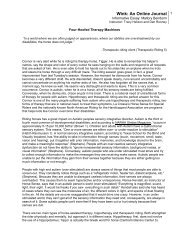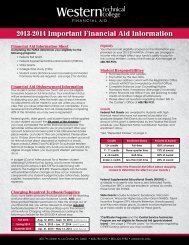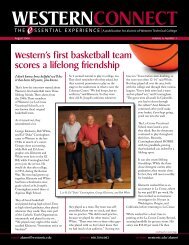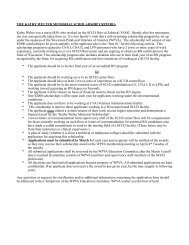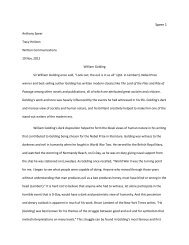The History of Western Technical College
The History of Western Technical College
The History of Western Technical College
You also want an ePaper? Increase the reach of your titles
YUMPU automatically turns print PDFs into web optimized ePapers that Google loves.
November Rudolph Serkin, a well known pianist in the United States and Canada, was guest artist with the<br />
Community Concert Association.<br />
November 24 Jan Struther, a London author and journalist, and author <strong>of</strong> Mrs. Miniver, spoke on<br />
“Your Country and Mine.”<br />
December 4 Draper (a tap dancer) and Adler (a harmonica player) gave a joint recital <strong>of</strong> classic and modern music<br />
and toe tapping finery.<br />
January 1942 began a series <strong>of</strong> ten weekly Thursday evening forum-lectures on current war problems. Grant C. Haas <strong>of</strong><br />
Madison, a lecturer, broadcaster and columnist on world affairs, conducted the series. <strong>The</strong> topics included:<br />
� Japan’s Desperate Attack � Inside <strong>The</strong> Axis<br />
� <strong>The</strong> Battle <strong>of</strong> Russia � <strong>The</strong> Strategy <strong>of</strong> Raw Materials<br />
� War in the Near East � Democracy—What is it?<br />
� Battle <strong>of</strong> the Atlantic � <strong>Western</strong> Hemisphere Collaboration<br />
� Europe’s Basic Problems � <strong>The</strong> President’s Foreign Policy<br />
Night school enrollment in 1942 soared to 8,000.<br />
<strong>The</strong> City <strong>of</strong> La Crosse budget for 1942 included 23.3 percent <strong>of</strong> its revenue for schools, <strong>of</strong> which 20.4 percent was for the<br />
La Crosse Public Schools and 2.9 percent for the Vocational School.<br />
In March 1942, Director Coleman was named director <strong>of</strong> the civilian defense countywide training school. Plans were<br />
made for setting up the school to train air raid wardens, fire wardens, drivers, bomb squad members, firewatchers,<br />
auxiliary police and auxiliary firemen. <strong>The</strong> sub-basement under the Auditorium was a designated portion <strong>of</strong> the school<br />
building for use as a fall-out shelter in case <strong>of</strong> an air raid.<br />
“Community Victory Programs” – the theme <strong>of</strong> the Victory Programs was “Distinguished Service in Our Homes is<br />
Distinguished Service to the Nation – were inaugurated in 1942, and sponsored by the Homemaking Department <strong>of</strong> the<br />
La Crosse Vocational School along with seven local women’s organizations. A series <strong>of</strong> free monthly lectures, tuned to<br />
the theme <strong>of</strong> “victory” were <strong>of</strong>fered and all women in the county were invited. Among the program subjects were<br />
clothing, food and nutrition, home management and family economics, women’s part in defense, and gardening.<br />
In 1942, a unique recruiting and training program, the first <strong>of</strong> its kind in the United States, as the army, the<br />
La Crosse Vocational School and the U.S. employment <strong>of</strong>ficials collaborated to staff Camp McCoy with civilian workers.<br />
Between 400 and 600 civilian workers were needed at the post exchanges or canteens that provided important centers<br />
for social relaxation by the soldiers. <strong>The</strong> Employment Office supplied the applicants . . . the Vocational School trained<br />
them . . . and the Army hired them.<br />
In 1942, sixty used typewriters, overhauled by the Rowley Office Equipment Company (corner <strong>of</strong> Third and Main Streets),<br />
were purchased by the U.S. Government and sent to federal government <strong>of</strong>fices throughout the nation.<br />
March 8, 1942, memorial services were held for four men who died on December 7, 1941 (Pearl Harbor), and two others<br />
who died on December 30, 1941 and on February 11, 1942.<br />
In May 1942, housewives and mothers took “refresher” courses for wartime employment. <strong>The</strong>y enrolled in courses such<br />
as shorthand, typewriting, business machines, and others for reentry into the commercial world.<br />
August 1942 – Grim looking welders turned out to be “pretty girls!” Organized in response to the need for women<br />
welders in defense industries, the girls’ class was an experiment. “It’s no harder than doing farm work or working at<br />
home,” said one student.<br />
In September 1942, Director Coleman received a job <strong>of</strong>fer to head a new vocational school in New Jersey, and told the<br />
Vocational Board that he was undecided as to what to do. Board President Raymond Bice spoke the sentiments <strong>of</strong> the<br />
Board Members when he told Coleman, “If you leave . . . not only the school, but the entire community will feel the loss.”<br />
An article in the November 15, 1942 edition <strong>of</strong> <strong>The</strong> La Crosse Tribune, tells a story <strong>of</strong> the painting “When Parents Fail.”<br />
<strong>The</strong> article read:





